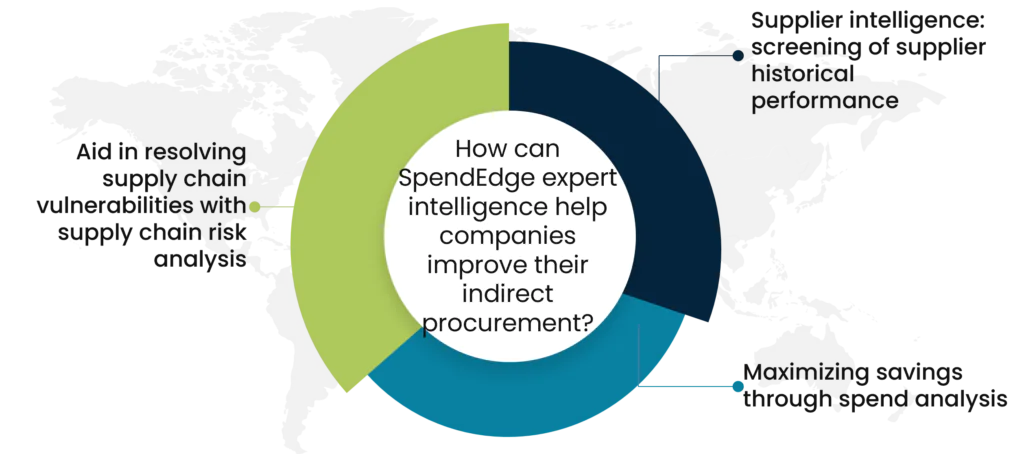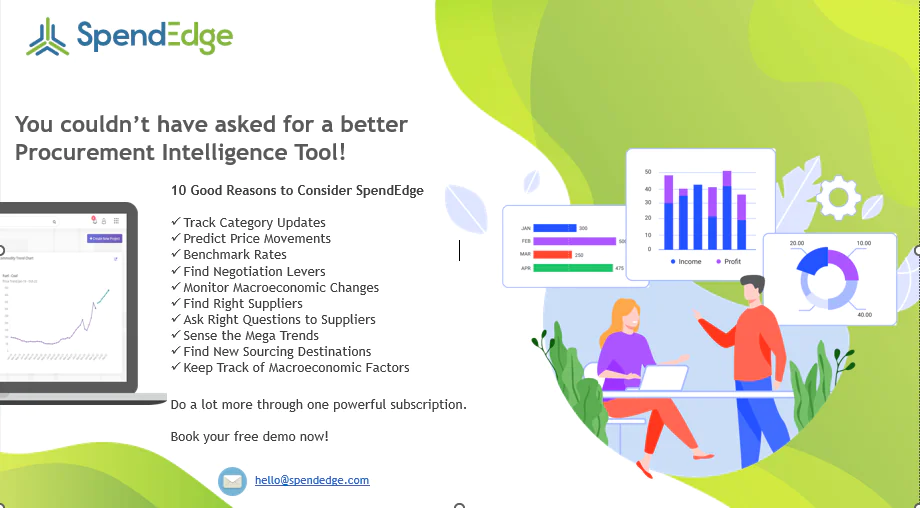Indirect procurement refers to the process of acquiring goods and services that are not directly involved in manufacturing a business. These items are purchased in order to support and improve the business’s operations. Indirect procurement typically involves internal stakeholders, such as business units or functions, rather than external customers or clients. There are several categories of indirect spending, including marketing, rent, capital expenditure, private-label packaging, facilities, and outsourced services.
Better indirect procurement can help companies maximize savings by optimizing the acquisition of non-core goods and services. Streamlining supplier relationships, leveraging economies of scale, and implementing cost-effective procurement technologies enable lower costs. Improved supplier negotiations, contract management, and spend analysis to identify savings opportunities. Additionally, increased compliance and risk management reduce unforeseen expenses. Altogether, these actions enhance operational efficiency and bolster a company’s bottom line, ultimately leading to substantial savings.
Challenges faced by procurement teams of corporations while acquiring indirect material and services
Difficulty in finding appropriate vendors for indirect procurement:
Finding appropriate vendors for indirect procurement can be challenging due to several factors. The sheer variety of indirect goods and services required, from office supplies to IT support, demands a diverse pool of vendors. Evaluating vendor reliability, quality, and pricing amidst this diversity necessitates substantial time and effort. Managing supplier relationships to ensure consistent supply and compliance can be complex. Additionally, market fluctuations, regulatory changes, and unforeseen disruptions further complicate vendor selection. Hence, the difficulty lies in balancing the need for cost-effective solutions with the imperative of maintaining high standards and adaptability in an ever-evolving procurement landscape.
Alarming rates of Indirect material/service pose a big challenge:
The challenge posed by alarming rates in indirect material and service procurement lies in striking the right balance between vigilance and operational efficiency. Indirect procurement encompasses a diverse array of goods and services, ranging from office supplies to facility maintenance. Establishing appropriate alarm or monitoring thresholds for each category requires careful consideration. Conversely, setting alarm rates too high can result in a flood of alerts that overwhelm procurement teams and disrupt regular operations. The challenge lies in determining the optimal alarm rates that ensure cost control and compliance without impeding day-to-day workflows.
Tracking supply chain risks: a strenuous task
Managing indirect procurement involves dealing with a wide range of indirect supplies, which can make its supply chain intricate. This complexity can lead to disruptions in the supply chain. It is essential to track and trace supply chain vulnerabilities to ensure the smooth flow of indirect supplies. This issue is also rooted in limited visibility, diverse risk types, data availability, changing landscape, and resource constraints associated with this type of procurement. Addressing these challenges requires a well-structured risk management strategy and the use of technology to enhance transparency and monitoring capabilities.
How can SpendEdge expert intelligence help companies improve their indirect procurement?

Supplier intelligence: screening of supplier historical performance
Our team conducts a thorough analysis of the indirect service supplier market and narrows down the list of potential suppliers by clearly defining the desired business outcomes. You can sift through the pool of suppliers to effectively understand the available options. We help you understand the critical criteria that are necessary for a successful supplier engagement. Our insights equip you with the essential know-how on recent supplier market developments, allowing you to devise sound strategies to ensure business continuity and profitability. Additionally, we help you track supplier risks that can disrupt the procurement process and identify mitigation measures adopted by suppliers to combat risk.
Maximizing savings through spend analysis:
As the costs of indirect services continue to rise, it is crucial to implement spend management practices to maximize savings and reduce procurement expenses. At SpendEdge, we conduct spend analysis to identify purchases made from unapproved suppliers, which can result in compliance failure and increase costs due to lack of negotiation. We help you gain transparency into your organization’s spend, providing oversight of expenditures and reducing the likelihood of fraud. This data can be used to evaluate suppliers and implement cost-reduction strategies effectively. By having a clear view of their spending patterns, companies can make informed decisions based on their budget and priorities.
Aid in resolving supply chain vulnerabilities with supply chain risk analysis:
By leveraging our expertise and resources we employ a data-driven approach to assess your supply chain vulnerabilities, identifying potential risks related to suppliers, geopolitical factors, market fluctuations, and more. We use advanced analytics and market insights to create risk mitigation strategies, helping organizations make informed decisions. Our services include supplier risk assessment, market intelligence, and supplier performance monitoring. By partnering with our SpendEdge experts, businesses can proactively manage and mitigate supply chain risks, ensuring resilience and continuity in their procurement operations.
Success Story: A fertilizer manufacturer used SpendEdge professionals’ expertise
Procuring supplies for a fertilizer manufacturing company can be complex. The company requires various indirect supplies, such as packaging materials for fertilizer bags, maintenance and repair supplies for equipment, laboratory equipment and supplies, IT and software services, and energy and utilities. However, companies are facing issues while procuring these supplies.
A manufacturer of fertilizer in North America who was also dealing with rising indirect procurement costs and wanted to cut back on tail spending on indirect categories was our customer. The business sought help from SpendEdge and asked for a workable solution.
Our team of SpendEdge experts conducted a thorough analysis of tail spend by utilizing spend analysis techniques. As a result, the client was able to achieve greater transparency in their spending. This approach allowed the client to gain a comprehensive understanding of their expenditures and minimized the chances of fraudulent activities. Additionally, our supplier intelligence helped the client in selecting the most suitable suppliers for various categories. Our methodology involved evaluating the suppliers’ past performance, identifying any potential supplier risks, and ensuring that the suppliers comply with various regulations.





